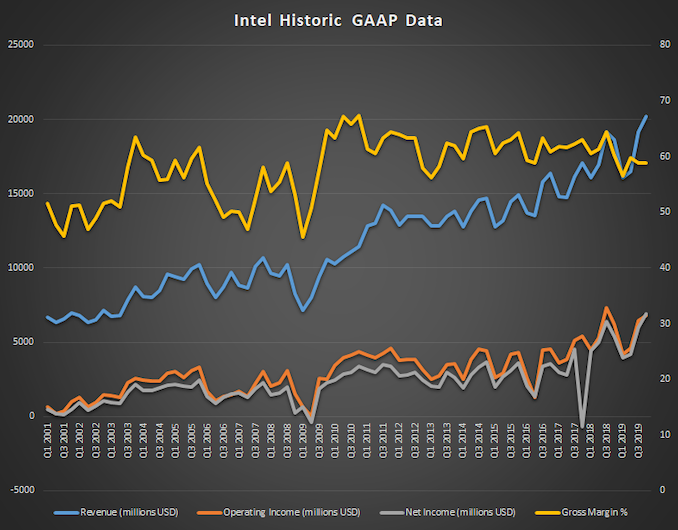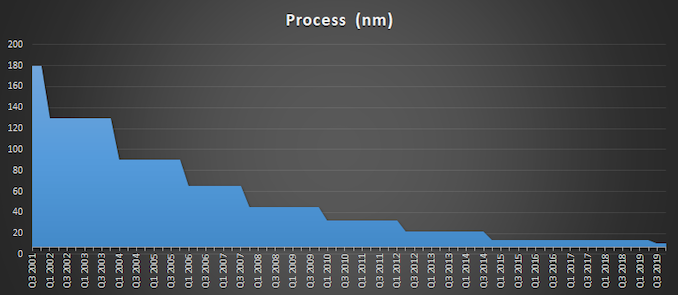Intel Q4 FY 2019 Results: Record Quarter, Record Year
by Brett Howse on January 23, 2020 8:45 PM EST- Posted in
- CPUs
- Intel
- Financial Results

Today Intel announced their earnings for the fourth quarter of their 2019 fiscal year. In terms of revenue, Intel had their highest ever Q4 revenue, coming in at $20.2 billion, and the full 2019 fiscal year, which was $72 billion. On a year-over-year basis, the results were up 8% and 2% respectively. Intel’s margins did slip a bit though, falling 1.4% to 58.8% of revenue. Operating income for the quarter was $6.8 billion, up 9% from last year, and net income was up 33% to $6.9 billion. This resulted in earnings-per-share of $1.58, up 40% from a year ago.
| Intel Q4 2019 Financial Results (GAAP) | |||||
| Q4'2019 | Q3'2019 | Q4'2018 | |||
| Revenue | $20.2B | $19.2B | $18.7B | ||
| Operating Income | $6.8B | $6.4B | $6.2B | ||
| Net Income | $6.9B | $6.0B | $5.2B | ||
| Gross Margin | 58.8% | 58.9% | 60.2% | ||
| Client Computing Group Revenue | $10.0B | +3% | +2% | ||
| Data Center Group Revenue | $7.2B | +12% | +19% | ||
| Internet of Things Revenue | $1.16B | +16% | +16% | ||
| Mobileye Revenue | $229M | +14% | +20% | ||
| Non-Volatile Memory Solutions Group | $1.2B | -7.7% | +10% | ||
| Programmable Solutions Group | $505M | flat | -17% | ||
Intel’s Client Computing Group, or CCG, had revenues of $10.0 billion for the quarter, up 2% from a year ago. Intel attributes the growth to modem sales and desktop platform volume. Intel is of course moving out of the 5G modem business, but will maintain its other connectivity offerings in the CCG such as their Wi-Fi products. Notebook platform volumes were down 1% in this quarter, with average selling prices staying flat, but desktop platform volumes were up 7%, but average selling prices fell 4%. Intel has said that they are expecting their chip shortage to be over by the end of this fiscal year.
Intel’s Data Center Group had revenue of $7.2 billion, up 19% from a year ago. Data Center sold 12% more unit volume this quarter than Q4 2018, and also added in 5% more average selling price per unit, so Intel’s DCG group is still very healthy.
Internet of Things, which include Mobileye, achieved revenue of $1.16 billion, up from $999 million a year ago. IoT was up 13%, accounting for $920 million of that revenue, and Mobileye was up 31% to $240 million.
Non-volatile Storage had revenue of $1.2 billion for the quarter, up 10% from a year ago which Intel is attributing to both NAND and Optane bit growth.
Programable Storage was the one area where Intel had a revenue drop, falling 17% year-over-year to $505 million, with no explanation given, but clearly FPGAs were in shorter demand.
Looking ahead to Q1 2020, Intel is expecting approximately $19.0 billion in revenue for the quarter, with earnings-per-share of $1.23.
Source: Intel Investor Relations












67 Comments
View All Comments
eva02langley - Thursday, January 23, 2020 - link
Sure, but what happens in 2020... will be hard to have shortage when people are buying the competition.imaheadcase - Thursday, January 23, 2020 - link
Not this again, don't ever base a company on one product. Its like saying Google only does Android OS and compare it to everything else. Its silly and does not point to a company as a whole on how they operate.Makaveli - Thursday, January 23, 2020 - link
This.Intel makes more in a quarter than AMD does for the year. Even with the success of Ryzen this is still David vs Goliath.
Korguz - Thursday, January 23, 2020 - link
yep.. but look what amd did with alot less cash then what intel did.... much for efficient with the funds they haveCiccioB - Friday, January 24, 2020 - link
AMD simply was lucky about TMSC 7nm PP vs Intel investing in a now failed but at the time very promising 10nm PP.Would have Intel had its 10nm out 2 years ago AMD would not have been at this point.
Would have TMSC created another 20nm shit they would be fried by now.
So great job AMD for having created an architecture that is not a failure as the two previous ones, but the point in the market they occupy now is just due to Intel fails for having bet on the creation of a too optimistic PP.
Now see what will happen when Intel resolves its problems with the PP and will come back with:
1, complete new architecture (with Keller's contributions)
2. new buses for joining chiplets (something AMD has not)
3. 3D stacking (which AMD has not)
See that with a better PP that Intel can use now, AMD is challenging an architecture which is, read carefully, 9 YEARS OLD! And it's main advantage is just the power consumption provided by the new PP (which is merit of TSMC, not AMD). Performance related, Intel is in par if not still ahead of AMD achievements 9 years later.
yeeeeman - Friday, January 24, 2020 - link
Finally a person that thinks. I really don't understand why people say amd won because they are amazingly better. It is like saying that a tennis player is the champion after match where the opponent plays with a broken leg. For sure he will win.Zen 2 is a good architecture, no doubt about that but there is nothing special about it. It is a tad bit better in ipc compared to a 5 year old one that is Skylake. Ice lake, which was targeted for 2017 is 10% better than a 2019 and product, just to put things in context. The key ingredient to amd succes is tsmc. That process allowed them to cram so much capability into their products. Chiplet architecture was also a key point but just look at what the results were with a bad process, not amazing (talking about 2xxx series).
So yeah, Intel is doing great now because they have a momentum and because they have support. Oems love to do their products as easy as possible and amd, even if they have great products now, they still are too small to work very closely with all the oems at the level Intel is a working now. If things will continue in this way, yes, in 2-3 years we might see Intel go quite a bit down and amd raise its capital significantly. But in the end, you can do so much with selling only CPUs and gpus. You need to diversify and Intel is staying afloat just because of that.
Korguz - Friday, January 24, 2020 - link
" Intel is doing great now because they have a momentum and because they have support. " they are ?? maybe with their financials, but when you over charge for your products....Carmen00 - Friday, January 24, 2020 - link
I'm probably going to regret writing this comment, but ... yes and no. What you have written is a very simplistic analysis, maybe so simple that it borders on misleading. Yes, TSMC's 7nm is now playing a big part. However, original Ryzen was on TSMC's 10nm (14nm++++ -comparable) process and has some genuine architectural improvements such as Infinity Fabric. To claim otherwise is to do a disservice to some very ingenious engineers and to the architecture itself. The architecture was also very forward-looking... 3 generations on AM4, with big improvements per generation, is not to be scoffed at. As for Intel, there are organizational issues at work too. Krzanich took his eye off the CPU performance ball and Swan is keeping his eye firmly off that ball too. He wants to play in 30% of ALL silicon rather than 90% of CPUs, and the technology development is reflecting that. Foveros is nice, but apply it to CPUs and you've got a thermal nightmare that needs handling. Apply it to other silicon and you'll be fine. So the fact is that as I see it, Intel may not even want to compete at this level, and that makes perfect business sense to me. Diversify and there is much less business risk. Su is an engineer and that comes through clearly ... AMD actually WANTS the crown. Swan is a businessman who's been in a CFO role for most of his recent life.To be honest, maybe this is too simplistic an analysis too. But at least it's a bit more reflective of reality...
Rudde - Friday, January 24, 2020 - link
"original Ryzen was on TSMC's 10nm"Source, please. As far as I know, Ryzen was built on Globalfoundries' 14 and 12 nm processes (licensed from Samsung).
Carmen00 - Friday, January 24, 2020 - link
Apologies for misinformation, Rudde is correct. It was 14nm / 12nm. Thanks for the correction.